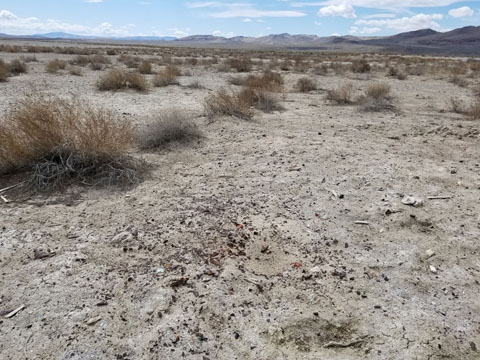White Plains, Huxley, &
Desert Crystal Salt Works
The future location of White Plains was originally traversed by the Truckee River Route of the California Trail beginning in the 1840s (this route split off of the Carson Trail, which crossed the 40 Mile Desert, at the Humboldt Sink, around seven miles away). In 1868, the Central Pacific Railroad (Transcontinental Railroad) was constructed across Nevada, roughly following the same route, and a station called White Plains was established, likely named for the expansive alkali flats in the area.
In 1870, Walter Schmidt started the Desert Crystal Salt Company and constructed two sets of evaporators near White Plains. The first was located three miles southeast of White Plains near the future location of Huxley, and the second set built in 1877 2½ miles southwest. At the first set of evaporators, Schmidt built a house, stable, and salt mill. Salt was transported by wagon to the railroad at White Plains, and much of it was shipped to silver camps for ore production. Meanwhile at White Plains, a small town developed centered around the Desert Crystal's business. A railroad depot was built, and in 1879 a post office and telegraph office were opened. White Plains even gained the county's first newspaper - the weekly Churchill News - in 1888.
Little White Plains continued to produce roughly 200 tons of salt each year for over a decade. In the 1890s, however, salt production began to slow. In 1902, the railroad (now owned by Southern Pacific) was re-routed through Hazen in order to bypass White Plains Hill, and White Plains was bypassed in the process. A new siding and station, called Huxley, was created along the new line, and it became the new shipping point for Desert Crystal. The White Plains post office was also moved to the new location. Unfortunately, Huxley never grew in importance like White Plains, and the post office was closed in 1909, followed by the end of salt production sometime between 1912 and 1915.
In addition to salt production, a lime kiln was also erected at Huxley in 1910 to derive lime from a limestone deposit just to the north. A small amount was shipped to the Pacific coast for agricultural uses, but the kiln too was abandoned by 1915.























